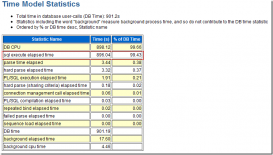|
1
2
3
|
instr(title,'手册')>0 相当于 title like '%手册%'instr(title,'手册')=1 相当于 title like '手册%'instr(title,'手册')=0 相当于 title not like '%手册%' |
t表中将近有1100万数据,很多时候,我们要进行字符串匹配,在SQL语句中,我们通常使用like来达到我们搜索的目标。但经过实际测试发现,like的效率与instr函数差别相当大。下面是一些测试结果:
|
1
2
3
4
5
6
7
8
9
10
11
12
13
14
15
16
17
18
19
20
|
SQL> set timing onSQL> select count(*) from t where instr(title,'手册')>0; COUNT(*) ---------- 65881 Elapsed: 00:00:11.04 SQL> select count(*) from t where title like '%手册%'; COUNT(*) ---------- 65881 Elapsed: 00:00:31.47 SQL> select count(*) from t where instr(title,'手册')=0; COUNT(*) ---------- 11554580 Elapsed: 00:00:11.31 SQL> select count(*) from t where title not like '%手册%'; COUNT(*) ---------- 11554580 |
另外,我在结另外一个2亿多的表,使用8个并行,使用like查询很久都不出来结果,但使用instr,4分钟即完成查找,性能是相当的好。这些小技巧用好,工作效率提高不少。通过上面的测试说明,ORACLE内建的一些函数,是经过相当程度的优化的。
|
1
2
|
instr(title,'aaa')>0 相当于likeinstr(title,'aaa')=0 相当于not like |
特殊用法:
|
1
|
select id, name from users where instr('101914, 104703', id) > 0; |
它等价于
|
1
|
select id, name from users where id = 101914 or id = 104703; |
使用Oracle的instr函数与索引配合提高模糊查询的效率
一般来说,在Oracle数据库中,我们对tb表的name字段进行模糊查询会采用下面两种方式:
|
1
2
|
select * from tb where name like '%XX%'; select * from tb where instr(name,'XX')>0; |
若是在name字段上没有加索引,两者效率差不多,基本没有区别。
为提高效率,我们在name字段上可以加上非唯一性索引:
|
1
|
create index idx_tb_name on tb(name); |
这样,再使用
|
1
|
select * from tb where instr(name,'XX')>0; |
这样的语句查询,效率可以提高不少,表数据量越大时两者差别越大。但也要顾及到name字段加上索引后DML语句会使索引数据重新排序的影响。
以上所述是小编给大家介绍的Oracle中Like与Instr模糊查询性能大比拼,希望对大家有所帮助,如果大家有任何疑问请给我留言,小编会及时回复大家的。在此也非常感谢大家对服务器之家网站的支持!
原文链接:http://blog.csdn.net/qdseashore/article/details/72457356
















